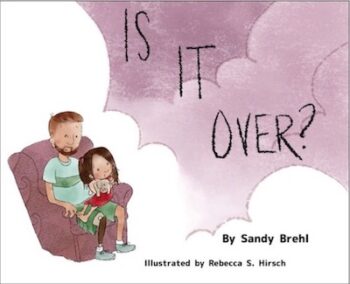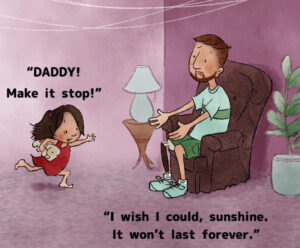
PenIt! Publications | ISBN: 978-1-952894-32-9 (Hardcover) | ISBN 978-1-954868-76-2 (Paperback)
Clouds tower. Waves crash. A storm is on its way and Risa is afraid. She runs to Daddy. “Make it stop!”
Dad comforts Risa, gently reminding that soon the storm will pass and all will be well. But as the winds grow louder, Risa isn’t so sure. Though she tries to comfort Ivan, her stuffed elephant, a sudden RRROAR! and CRRRACK! send Risa running to Daddy’s arms. Can’t he do something about the noise and rain, thunder and lightning?
It’s then that Risa feels Daddy’s heart race. Could he be scared, too?
“When I was your age, I loved storms. Skies were stages for my imagination.”
That’s how it used to be. But during his time as a solider, Dad’s stories changed. Now, it’s Risa’s turn to use her imagination to tell a story that calms them all. Risa’s simple, but beautiful words help her and her dad weather the storm. Before they know it, the storm has passed and the three have shared a pivotal moment together.
I was curious to learn more and was lucky enough to ask author Sandy Brehl a few questions.
DIANNE: Welcome to ReaderKidZ, Sandy! Let’s talk about your debut picture book, IS IT OVER?, illustrated by Rebecca S. Hirsch. What were the seeds for this story?
SANDY: Thanks so much for welcoming me and for your kind words about IS IT OVER?
So, here’s how this story began:
“Once upon a time” I wrote a sort-of-chapter book for my parents’ 45th anniversary. Each chapter, although fiction, was based on some of the creative ways my parents had found to delight the four of us siblings on a shoestring budget. One chapter was set at a rented cabin on Lake Erie during a fierce thunderstorm. My parents and grandparents each told a reassuring story about what caused all the noise and lights: angels bowling, jousts and flashing swords, even God taking flash pictures of us on Earth. That was the one chapter that friends and family always mentioned, so I began WAY back then to look for ways to write it as a picture book.
DIANNE: That’s fascinating!
The book starts with a prowling, growling thunderstorm and Risa is scared. But there’s a gentle revelation in the middle. It’s such an important turning point in the story and I’m curious, did you always plan to include the line about how Dad’s feelings for storms?
SANDY: Not at all. Narrowing the focus from my full-family storm-story to Daddy, Risa (and Ivan) came about because I read so many fear-of-storms picture books that used an outside force to comfort the frightened child. In this case, I wanted Risa to rescue herself and to feel empathy beyond her own struggles. That’s when the triggering effect of storms on adults came to mind. I considered various approaches, thinking first of WWII veterans, like my Dad from the “Greatest Generation”, who likely returned from unspeakable battles with as-yet-unnamed PTSD. Then I moved to the countless veterans (men and women) of the past two decades who returned from deployments individually, without a cohort nearby who might recognize and share their reactions to loud storms, sudden noises, fireworks, etc. My biggest challenge was deciding how to portray adult fear and topics about war in an age-appropriate way for young audiences.

CLICK TO ENLARGE © illustration by Rebecca S. Hirsch
DIANNE: I see… one idea led you to the next! Isn’t it wonderful how that happens?
Many of those who read picture books don’t realize how hard it can be to capture strong emotions in as few words as possible. You’ve done that in a way that packs a punch.
SANDY: Thank you for that, Dianne. As I said, this one began as a full chapter! I’m never at a loss for words, so I tend to pour them ALL onto the page in the first round. Only then can I sort out whose story it really is (not MINE!) and work through what it is they do (or DON’T) need to actually show or say, leaving room for the illustrator.
I was anxious to see what Becky (Rebecca S. Hirsch) would do with it. In the end, she captured the heart and power of this story so well that it could nearly have been a wordless book. As a result, even more words were trimmed, and I was happy to let them go!
DIANNE: We learn midway through the book that Dad was a soldier, and it wasn’t until then that I noticed that he had a prosthesis. Did you and the illustrator collaborate on the art? What, if any, communication did you and Becky have as the project went forward?
SANDY: I’m so pleased to have you say that. That’s very much the reaction I was aiming for, a subtle suggestion rather than centering it in the story. Becky began with only the text of the story, no art notes. I didn’t know it until the early art arrived, but Becky researched a variety of actual prosthetic models until she found something that could suit the character and story so naturally that readers, too, might overlook it, or just assume it didn’t matter. Then, once Daddy’s background came through, there’s awareness, a sort of “A-HA” moment.
The MANY veterans of multiple deployments are family members of an entire generation, yet references to their experiences rarely appear in picture books except as a tragic or heroic or service story. I was eager to provide a daily-life story that allows those families to find themselves on the page.
As for collaboration, one benefit of working with a small traditional press is that this was possible. Becky and I exchanged email notes at various stages in the process, with my side of that tending toward cheers for her work, from her earliest character sketches to final illustrations. She also shared the full dummy with her art critique partners. When she passed along several of their helpful comments to me, some of those notes affected the final art.
DIANNE: As authors of picture books, we generally have an audience in mind. A special reader that we hope to reach with these words and this book (and it isn’t necessarily always the same from book to book).
Is there a specific reader or readers you hope will find IS IT OVER? and what do you hope they’ll carry inside them by book’s end?
SANDY: The dedication is to my niece, now married, mother of two, and a respected professional. As a child, though, she was terrified of storms, to the point of panic attacks. As an educator, teaching many ages, there were always a few students whose stress during a thunderstorm was visible. My original and intentional audience is any child who feels overwhelmed by storms. Its many revisions led me to imagine several new readers: children of families with veterans, of course, and the veterans themselves who might share the book with little ones.
DIANNE: That’s so wonderful. Thank you for your thoughtful replies and for sharing the “inside scoop,” Sandy!
And finally, the question we ask at the end of every interview: What are you working on now?
SANDY: One current picture manuscript (among MANY!) is a non-fiction collaboration with two members of the Gallaudet Eleven, pioneers in human space travel. The team of Deaf men had a difference that was exactly what NASA needed. Theirs is very much a sort of “Hidden Figures” story, only now coming to public attention after fifty years of silence.
DIANNE: That sounds fascinating, Sandy! Good luck!
SANDY: Thank you, Dianne, for the invitation to join you here with your readers!
DIANNE: Thank YOU! 🙂
Learn more about Sandy’s books and Becky’s illustrations on their websites:











Thanks for the warm welcome, Dianne.
As you indicated, there are countless words that preceded the brief text that eventually appears on picture book pages. It’s always the goal to make sure that the ones that do are the “just right” words for the story.
It’s a beautiful story, Sandy. Congratulations! I hope IS IT OVER? finds its way into the hands of many children.